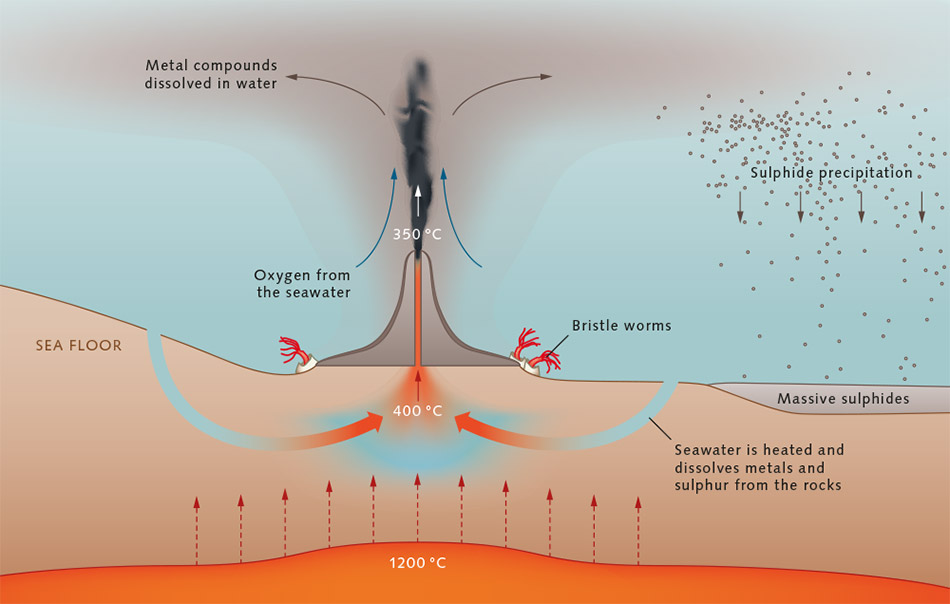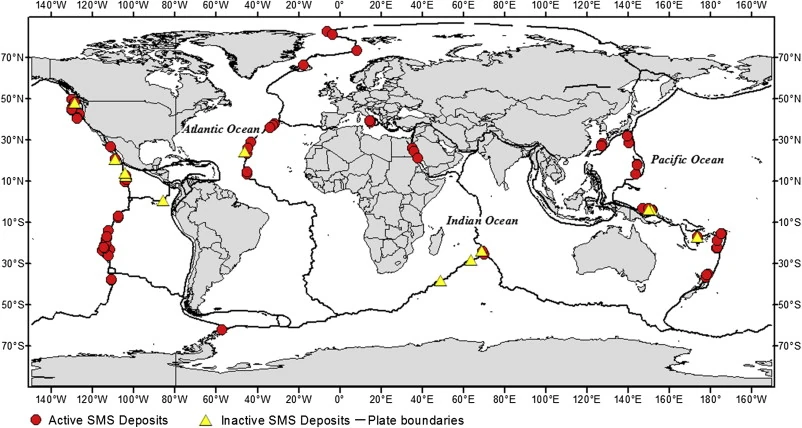Polymetallic Sulphide Deposits
Introduction
Polymetallic sulphide deposits are rich sources of metals such as copper, zinc, gold, and silver, found on the ocean floor. These deposits occur in regions where hot, mineral-rich fluids from the Earth's mantle are expelled into the ocean, leading to the precipitation of metal sulphides. This article aims to explain the formation of polymetallic sulphide deposits in the ocean, their distribution, economic importance, and potential environmental impacts.
Formation of Polymetallic Sulphide Deposits
Polymetallic sulphide deposits form at hydrothermal vent sites, where superheated water from the Earth's mantle interacts with the cold ocean water, resulting in the precipitation of metal sulphides. The process of formation can be divided into the following steps:
1. Hydrothermal Circulation
In regions where tectonic plates are diverging or converging, cracks and fissures form in the Earth's crust, allowing seawater to penetrate into the hot rock below. As the seawater descends, it is heated by the surrounding rock and reacts with the minerals in the crust, dissolving metals and other elements. This heated, mineral-rich water is then expelled back into the ocean through hydrothermal vents.
2. Precipitation of Metal Sulphides
As the hot, mineral-rich fluid mixes with the cold ocean water, the metals in the fluid react with sulphur in the seawater to form metal sulphides. These sulphides are insoluble in water and precipitate out of the solution, forming deposits on the ocean floor.

- Polymetallic sulphide deposits form at hydrothermal vent sites
- They form when hot, mineral-rich fluids from the Earth's mantle mix with cold ocean water, resulting in the precipitation of metal sulphides
Distribution of Polymetallic Sulphide Deposits
Polymetallic sulphide deposits are found in different regions of the ocean floor, primarily along mid-ocean ridges, back-arc basins, and active volcanic arcs. The distribution of these deposits is influenced by the tectonic setting and the geological characteristics of the region.
1. Mid-Ocean Ridges
Mid-ocean ridges are regions where tectonic plates are diverging, leading to the formation of new oceanic crust. These regions are characterized by high levels of volcanic and tectonic activity, which create the necessary conditions for hydrothermal circulation and the formation of polymetallic sulphide deposits.
2. Back-Arc Basins
Back-arc basins are regions located behind volcanic arcs, where the oceanic crust is being stretched and thinned. This stretching and thinning of the crust allows for the circulation of seawater through the hot rock below, leading to the formation of hydrothermal vents and polymetallic sulphide deposits.

- Polymetallic sulphide deposits are found along mid-ocean ridges, back-arc basins, and active volcanic arcs
- The distribution of these deposits is influenced by the tectonic setting and geological characteristics of the region
Economic Importance
Polymetallic sulphide deposits are of significant economic importance as they are rich sources of metals such as copper, zinc, gold, and silver. These metals are essential for various industries and applications, including electronics, construction, and renewable energy. With the depletion of land-based mineral resources, polymetallic sulphide deposits in the ocean are becoming increasingly important for meeting the global demand for metals.
- Polymetallic sulphide deposits are economically important as they are rich sources of copper, zinc, gold, and silver
- With the depletion of land-based mineral resources, ocean-based polymetallic sulphide deposits are becoming increasingly important
Environmental Impacts
The extraction of polymetallic sulphide deposits from the ocean floor has the potential to cause significant environmental impacts. The mining process can lead to the destruction of habitats, release of toxic substances into the ocean, and alteration of the seafloor topography. Furthermore, the discharge of mining waste into the ocean can lead to the smothering of marine organisms and the release of harmful substances into the water column. Therefore, it is essential to develop and implement environmentally friendly mining practices to minimize the environmental impacts of extracting polymetallic sulphide deposits from the ocean floor.
- The extraction of polymetallic sulphide deposits from the ocean floor can cause significant environmental impacts
- It is essential to develop and implement environmentally friendly mining practices to minimize these impacts
Conclusion
Polymetallic sulphide deposits are important sources of metals such as copper, zinc, gold, and silver, found on the ocean floor. These deposits form at hydrothermal vent sites, where hot, mineral-rich fluids from the Earth's mantle mix with cold ocean water, resulting in the precipitation of metal sulphides. The distribution of polymetallic sulphide deposits is influenced by the tectonic setting and geological characteristics of the region. While these deposits are economically important, their extraction can cause significant environmental impacts. Therefore, it is essential to develop and implement environmentally friendly mining practices to minimize the environmental impacts of extracting polymetallic sulphide deposits from the ocean floor.
References
- German, C. R., Petersen, S., & Hannington, M. D. (2016). Hydrothermal exploration of mid-ocean ridges: where might the largest sulfide deposits be forming?. Chemical Geology, 420, 114-126.
- Hannington, M., Jamieson, J., Monecke, T., Petersen, S., & Beaulieu, S. (2011). The abundance of seafloor massive sulfide deposits. Geology, 39(12), 1155-1158.
- Fouquet, Y., & Scott, S. D. (2016). Gold in polymetallic sulfide deposits formed by hydrothermal processes at mid-ocean ridges. Society of Economic Geologists Special Publication, 16